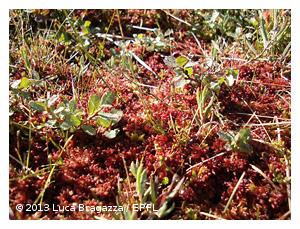How shrubs are disrupting our primary carbon stocking ecosystem

© 2013 Luca Bragazza - EPFL
For the first time, a group of scientists from WSL and EPFL described why on the long run peatlands may not be able to continue fulfilling their role as the most effective carbon stocking ecosystems. They studied the mechanisms behind a phenomenon known as shrub encroachment of peatlands: Complex plant-microbe interactions are at the root of this worldwide vegetation change. The findings have been published online today in Nature Climate Change.
Peatlands (bogs, turf moors) are among the most important ecosystems worldwide for the storage of atmospheric carbon and thus for containing the climate warming process. In the last 30 to 50 years the peat (Sphagnum) mosses, whose decay produces the peat (turf), have come under pressure by vascular plants, mostly small shrubs.
A new study by scientists from the Swiss Federal Institute for Forest, Snow and Landscape Research WSL and from the Ecole Polytechnique Fédérale de Lausanne describes for the first time what lies behind this change in vegetation and explains why vascular plants are at an advantage over peat (Sphagnum) mosses in a warmer climate.
The findings in a nutshell
The research team closely monitored four peatland sites at altitudes ranging from 600 m to 1900 m over a period of three years. The selected altitudinal gradient reflects the expected changes in climate conditions for the year 2050 in northern Switzerland. They observed that the increase of shrub cover and soil temperature along the altitudinal gradient were responsible for a decrease of almost 50% of the production of new litter by peat mosses, the main contributors to peat accumulation.
The analysis showed that vascular plants can increase the availability of soil nitrogen (a primary nutrient for plant growth) by means of specific compounds contained in their leaves. They exploit the nutrient for their growth through the mediation of specific fungal symbiosis at root level (the mycorrhiza), a process that becomes more and more frequent when soil temperature increases. At the same time, with higher soil temperature vascular plants release a greater amount of organic matter into the soil through their roots (the so called “root exudates”) and this stimulates the decomposition activity of soil microbes.
As fewer peat mosses grow, there will be less new peat to store atmospheric carbon. In addition, the increased decomposition activity of soil microbes accelerates the decomposition of old peat. Thus, carbon that might otherwise be kept in storage for millennia can be released into the atmosphere. This situation casts a black shadow on the capacity of peatlands to continue to accumulate atmospheric carbon. As a consequence, peatlands can turn from carbon sinks to carbon sources, thus intensifying the climate warming instead of contributing to reducing it.
Peatlands play a central role in climate protection![]()
 Although peatlands are estimated to cover only 3% of the world land surface, they store about 30% of all soil organic matter, an amount equivalent to about 50% of the atmospheric CO2. On global scale, peatlands stock an amount of carbon which is twice the carbon stock of all forest biomass. In this sense, peatlands can be considered as “hot spots” of carbon accumulation and they have contributed, over millennia, to cool the climate by retrieving greenhouse gases from the atmosphere.
Although peatlands are estimated to cover only 3% of the world land surface, they store about 30% of all soil organic matter, an amount equivalent to about 50% of the atmospheric CO2. On global scale, peatlands stock an amount of carbon which is twice the carbon stock of all forest biomass. In this sense, peatlands can be considered as “hot spots” of carbon accumulation and they have contributed, over millennia, to cool the climate by retrieving greenhouse gases from the atmosphere.
In Switzerland, peatlands have become known to the general public because of the Rothenturm initiative, which was followed by an article in the Swiss Constitution in 1987 to save peatlands from destruction.
In peatlands, the accumulation of peat is primarily promoted by a peculiar group of plants called “peat mosses” (technically, Sphagnum mosses), whose litter has antibiotic properties that hamper the decomposing activity of soil microbes. In addition, the presence of abundant water in peatland soil not only promotes the growth of peat mosses (which do not have roots, like vascular plants), but also creates anoxic conditions that further reduce the decomposition of plant litter. In a typical peatland, peat mosses dominate the landscape.